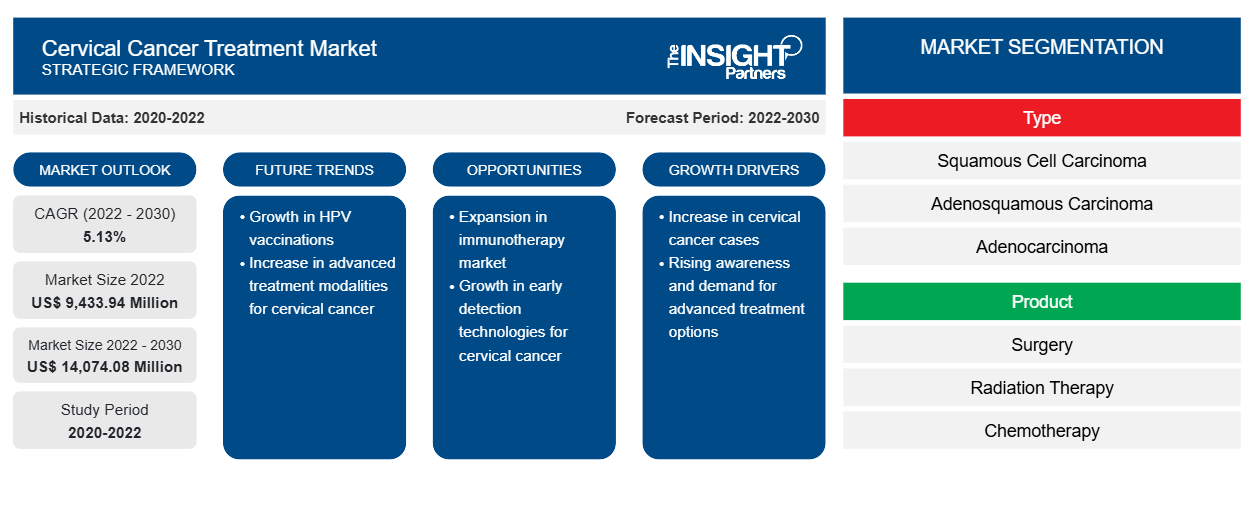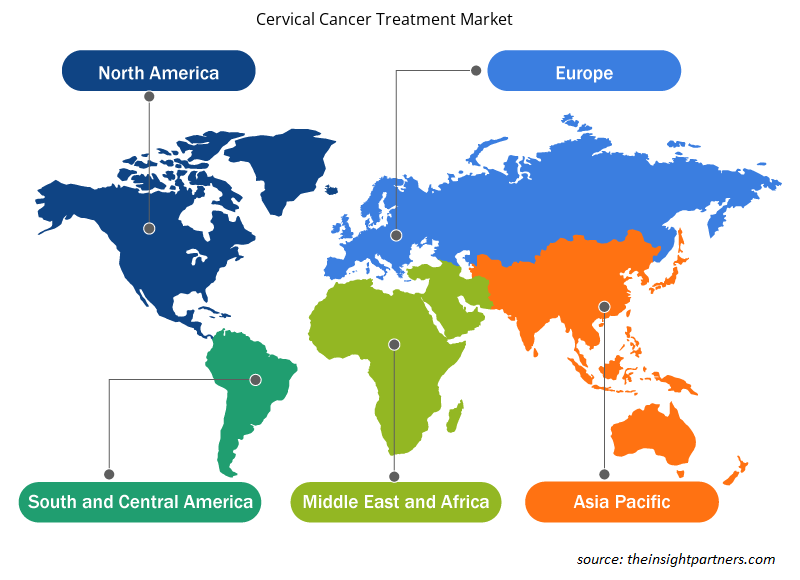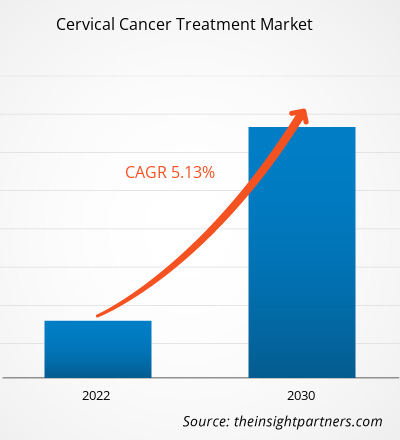[Research Report] The cervical cancer treatment market is projected to grow from US$ 10.26 billion in 2024 to US$ 14.91 billion by 2031; the market is anticipated to record a CAGR of 5.7% from 2025 to 2031.
Market Insights and Analyst View:
The cervical cancer treatment market forecast can help stakeholders to plan their growth strategies.
Cervical cancer refers to the cancer that occurs in the cells of the cervix, i.e., the lower part of the uterus that connects to the vagina. In 90% of the cases, cervical malignancies occur due to the HPV infection and are diagnosed through smear screening. The increasing prevalence of cervical cancer and the rise in HPV infections are the key factors driving the cervical cancer treatment market growth. However, the lack of awareness about the diagnosis and treatment methods hampers the growth of the market. Cervical cancer treatment market trends include the increasing R&D for cervical cancer diagnosis and drugs.
Growth Drivers and Challenges:
Increasing Prevalence of Cervical Cancer Fuels Cervical Cancer Treatment Market
Across the globe, cancer is becoming one of the main causes of mortality. According to the World Health Organization (WHO), cancer was the top cause of death for individuals under the age of 70 in 183 nations, while in 123 other countries, it was the fourth most common cause of death globally in 2019. Furthermore, according to the data released by the World Health Organization in March 2021, nearly 10 million fatalities in 2020 were attributed to various forms of cancer. The market under consideration has shown significant expansion, which can be linked to the rising frequency of cervical cancer among women worldwide. According to the World Health Organization (WHO), cervical cancer kills more than 270,000 women each year. Cervical cancer mortality rates are high in poorer nations due to the late discovery of the disease.
The increasing prevalence of cervical cancer has created a burden on the healthcare systems across the world. According to the International Agency for Research on Cancer (IARC), the global burden of new cancer cases is estimated to reach ~27.5 million, and the disease is likely to cause ~163 million deaths by 2040. Factors such as lifestyle changes, smoking, reduced physical activities, and uncertain health and climatic conditions are expected to increase the burden of cancer in the world in the coming years. Therefore, controlling and preventing the increasing number of cancers worldwide is essential.
The lack of awareness about cervical cancer among populations, healthcare providers, and policymakers; limited access to high-quality healthcare services and cervical screening programs; and a lack of functional referral systems are among the factors leading to the high incidence and mortality from cervical cancer. Cervical cancer incidence and mortality have lowered in industrialized countries owing to improved access to cytological screening and rapid treatment of early cervical lesions. It is critical to implement population-based cervical screening and increase its acceptance in low- and middle-income countries (LMICs) to reduce cervical cancer mortality. Raising awareness about risk factors such as first sexual intercourse at a young age and having multiple male sexual partners; the high risk associated with HPV types 8, 9, and 10; first full-term pregnancy at a young age; prolonged use of oral contraceptives; and HIV infections may help boost participation in screening programs. Better awareness regarding the symptoms of cervical cancer, such as intermenstrual vaginal bleeding, postmenopausal vaginal bleeding, post-coital vaginal bleeding, foul vaginal discharge, and lower abdomen pain, might help women seek early help. Thus, the lack of awareness about cervical cancer among populations hinders the cervical cancer treatment market growth.
Customize This Report To Suit Your Requirement
You will get customization on any report - free of charge - including parts of this report, or country-level analysis, Excel Data pack, as well as avail great offers and discounts for start-ups & universities
Cervical Cancer Treatment Market: Strategic Insights

- Get Top Key Market Trends of this report.This FREE sample will include data analysis, ranging from market trends to estimates and forecasts.
You will get customization on any report - free of charge - including parts of this report, or country-level analysis, Excel Data pack, as well as avail great offers and discounts for start-ups & universities
Cervical Cancer Treatment Market: Strategic Insights

- Get Top Key Market Trends of this report.This FREE sample will include data analysis, ranging from market trends to estimates and forecasts.
Report Segmentation and Scope:
Segmental Analysis:
Based on type, the market is segmented into squamous cell carcinoma, adenosquamous carcinoma, and adenocarcinoma. The squamous cell carcinoma segment held a larger cervical cancer treatment market share in 2022 and is anticipated to register a higher CAGR during 2022–2030. Based on product, the market is classified as surgery, radiation therapy, chemotherapy, immunotherapy, and therapeutic vaccines. The surgery segment is anticipated to hold a significant share by 2030. In terms of end user, the market is categorized into hospital, homecare, cancer centers, and others. In terms of end user, the hospital segment held the largest cervical cancer treatment market share in 2022.
Regional Analysis:
In terms of geography, the scope of the cervical cancer treatment market report encompasses North America, Europe, Asia Pacific, the Middle East & Africa, and South & Central America. North America held the largest cervical cancer treatment market share in 2022. In North America, the US holds a significant share. Constantly ongoing R&D activities, financial assistance from governments and other public and private organizations, partnerships between IT and pharmaceutical firms, and the rising incidences of neurological diseases primarily drive market growth in the country. Furthermore, strategic initiatives taken by the government to improve the testing procedures are anticipated to benefit the market during the forecast period. The increasing adoption of regulations pertaining to rare diseases will most likely present an opportunity for market expansion. For example, the American Cancer Society (ACS) revised the cervical cancer screening standards in September 2020.
Cervical Cancer Treatment Market Regional Insights
The regional trends and factors influencing the Cervical Cancer Treatment Market throughout the forecast period have been thoroughly explained by the analysts at Insight Partners. This section also discusses Cervical Cancer Treatment Market segments and geography across North America, Europe, Asia Pacific, Middle East and Africa, and South and Central America.

- Get the Regional Specific Data for Cervical Cancer Treatment Market
Cervical Cancer Treatment Market Report Scope
| Report Attribute | Details |
|---|---|
| Market size in 2024 | US$ 10.26 Billion |
| Market Size by 2031 | US$ 14.91 Billion |
| Global CAGR (2025 - 2031) | 5.7% |
| Historical Data | 2021-2023 |
| Forecast period | 2025-2031 |
| Segments Covered |
By Type
|
| Regions and Countries Covered | North America
|
| Market leaders and key company profiles |
Cervical Cancer Treatment Market Players Density: Understanding Its Impact on Business Dynamics
The Cervical Cancer Treatment Market is growing rapidly, driven by increasing end-user demand due to factors such as evolving consumer preferences, technological advancements, and greater awareness of the product's benefits. As demand rises, businesses are expanding their offerings, innovating to meet consumer needs, and capitalizing on emerging trends, which further fuels market growth.
Market players density refers to the distribution of firms or companies operating within a particular market or industry. It indicates how many competitors (market players) are present in a given market space relative to its size or total market value.
Major Companies operating in the Cervical Cancer Treatment Market are:
- F. Hoffmann-La Roche Ltd
- Merck Sharp
- Dohme Corp.
- GlaxoSmithKline plc.
- Genentech, Inc.
- Amgen Inc.
Disclaimer: The companies listed above are not ranked in any particular order.

- Get the Cervical Cancer Treatment Market top key players overview
Industry Developments and Future Opportunities:
The cervical cancer treatment market analysis is carried out by identifying and evaluating key players operating in the market. A few initiatives taken by key market players are listed below:
- In January 2024, Pfizer Inc. and Genmab A/S announced that the US Food and Drug Administration (FDA) accepted the supplemental Biologics License Application (sBLA) to convert TIVDAK's (tisotumab vedotin-tftv) approval for the treatment of patients with recurrent or metastatic cervical cancer whose disease progresses on or after first-line therapy. With a Prescription Drug User Fee Act (PDUFA) goal date of May 9, 2024, the application has been awarded Priority Review.
- In September 2023, Guangzhou Gloria Biosciences (GloriaBio) announced that Zimberelimab injection (YuTuo, GLS-010), a fully human anti-PD-1 monoclonal antibody, has been approved for marketing by the China National Medical Products Administration (NMPA). The injection can be used as a monotherapy to treat patients with recurrent or metastatic cervical cancer (R/M CC). The third immune checkpoint inhibitor (ICI) antibody approved worldwide for treating cervical cancer is zimberelimab—the first and only one authorized in China.
Competitive Landscape and Key Companies:
F. Hoffmann-La Roche Ltd, Merck Sharp, Dohme Corp., GlaxoSmithKline plc., Genentech Inc., Amgen Inc., Advaxis Inc., Biocon, Allergan Inc., Pfizer Inc., and AstraZeneca are a few key companies profiled in the cervical cancer treatment market report. These companies focus on expanding their offerings to meet the growing consumer demand worldwide. Their global presence allows them to serve many customers, subsequently allowing them to expand their market presence.
Frequently Asked Questions
Who are the major players in the cervical cancer treatment market?
The cervical cancer treatment market has major market players, including F. Hoffmann-La Roche Ltd, Merck Sharp, Dohme Corp., GlaxoSmithKline plc., Genentech Inc., Amgen Inc., Advaxis Inc., Biocon, Allergan Inc., Pfizer Inc., and AstraZeneca.
What was the estimated cervical cancer treatment market size in 2024?
The cervical cancer treatment market was valued at US$ 10.26 billion in 2024
Which slice product segment dominates the cervical cancer treatment market?
Based on product, the market is divided into surgery radiation therapy, chemotherapy, immunotherapy, and therapeutic vaccines..
What is cervical cancer treatment ?
Cervical cancer refers to the cancer that occurs in the cells of the cervix, i.e., the lower part of the uterus that connects to the vagina. In 90% of the cases, cervical malignancies occur due to the HPV infection and are diagnosed through smear screening.
What factors drive the cervical cancer treatment market?
The increasing prevalence of cervical cancer and the rise in HPV infections are the key factors driving the cervical cancer treatment market growth. However, the lack of awareness about the diagnosis and treatment methods hampers the growth of the market. Cervical cancer treatment market trends include the increasing R&D for cervical cancer diagnosis and drugs
What are the growth estimates for the cervical cancer treatment market till 2031?
The cervical cancer treatment market is expected to be valued at US$ 14.91 billion in 2031.
Which type segment dominates the cervical cancer treatment market?
Based on type, the cervical cancer treatment market is segmented into squamous cell carcinoma, adenosquamous carcinoma, and adenocarcinoma. The squamous cell carcinoma segment held a larger cervical cancer treatment market share in 2022 and is anticipated to register a higher CAGR during 2022–2030.
- Historical Analysis (2 Years), Base Year, Forecast (7 Years) with CAGR
- PEST and SWOT Analysis
- Market Size Value / Volume - Global, Regional, Country
- Industry and Competitive Landscape
- Excel Dataset
Testimonials
I wish to appreciate your support and the professionalism you displayed in the course of attending to my request for information regarding to infectious disease IVD market in Nigeria. I appreciate your patience, your guidance, and the fact that you were willing to offer a discount, which eventually made it possible for us to close a deal. I look forward to engaging The Insight Partners in the future, all thanks to the impression you have created in me as a result of this first encounter.
DR CHIJIOKE ONYIA, MANAGING DIRECTOR, PineCrest Healthcare Ltd.The Insight Partners delivered insightful, well-structured market research with strong domain expertise. Their team was professional and responsive throughout. The user-friendly website made accessing industry reports seamless. We highly recommend them for reliable, high-quality research services
Yukihiko Adachi CEO, Deep Blue, LLC.Reason to Buy
- Informed Decision-Making
- Understanding Market Dynamics
- Competitive Analysis
- Customer Insights
- Market Forecasts
- Risk Mitigation
- Strategic Planning
- Investment Justification
- Identifying Emerging Markets
- Enhancing Marketing Strategies
- Boosting Operational Efficiency
- Tracking Industry Innovations
- Aligning with Regulatory Trends
Yes! We provide a free sample of the report, which includes Report Scope (Table of Contents), report structure, and selected insights to help you assess the value of the full report. Please click on the "Download Sample" button or contact us to receive your copy.
Absolutely — analyst assistance is part of the package. You can connect with our analyst post-purchase to clarify report insights, methodology or discuss how the findings apply to your business needs.
Once your order is successfully placed, you will receive a confirmation email along with your invoice.
• For published reports: You’ll receive access to the report within 4–6 working hours via a secured email sent to your email.
• For upcoming reports: Your order will be recorded as a pre-booking. Our team will share the estimated release date and keep you informed of any updates. As soon as the report is published, it will be delivered to your registered email.
We offer customization options to align the report with your specific objectives. Whether you need deeper insights into a particular region, industry segment, competitor analysis, or data cut, our research team can tailor the report accordingly. Please share your requirements with us, and we’ll be happy to provide a customized proposal or scope.
The report is available in either PDF format or as an Excel dataset, depending on the license you choose.
The PDF version provides the full analysis and visuals in a ready-to-read format. The Excel dataset includes all underlying data tables for easy manipulation and further analysis.
Please review the license options at checkout or contact us to confirm which formats are included with your purchase.
Our payment process is fully secure and PCI-DSS compliant.
We use trusted and encrypted payment gateways to ensure that all transactions are protected with industry-standard SSL encryption. Your payment details are never stored on our servers and are handled securely by certified third-party processors.
You can make your purchase with confidence, knowing your personal and financial information is safe with us.
Yes, we do offer special pricing for bulk purchases.
If you're interested in purchasing multiple reports, we’re happy to provide a customized bundle offer or volume-based discount tailored to your needs. Please contact our sales team with the list of reports you’re considering, and we’ll share a personalized quote.
Yes, absolutely.
Our team is available to help you make an informed decision. Whether you have questions about the report’s scope, methodology, customization options, or which license suits you best, we’re here to assist. Please reach out to us at sales@theinsightpartners.com, and one of our representatives will get in touch promptly.
Yes, a billing invoice will be automatically generated and sent to your registered email upon successful completion of your purchase.
If you need the invoice in a specific format or require additional details (such as company name, GST, or VAT information), feel free to contact us, and we’ll be happy to assist.
Yes, certainly.
If you encounter any difficulties accessing or receiving your report, our support team is ready to assist you. Simply reach out to us via email or live chat with your order information, and we’ll ensure the issue is resolved quickly so you can access your report without interruption.















The List of Companies - Cervical Cancer Treatment Market
- F. Hoffmann-La Roche Ltd
- Merck Sharp
- Dohme Corp.
- GlaxoSmithKline plc.
- Genentech, Inc.
- Amgen Inc.
- Advaxis, Inc.
- Biocon
- Allergan, Inc
- Pfizer Inc
- AstraZeneca






 Get Free Sample For
Get Free Sample For